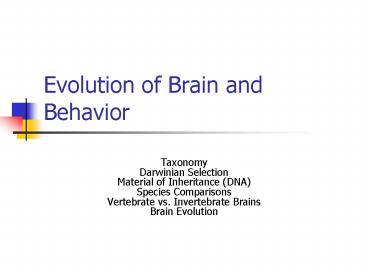Evolution of Brain and Behavior - PowerPoint PPT Presentation
1 / 15
Title:
Evolution of Brain and Behavior
Description:
Forebrain size correlated w/ song repertoire. Neuronal activation (ZENK) 7 functional ... Basic plan. Brain (trend towards increasing control over lower regions) ... – PowerPoint PPT presentation
Number of Views:63
Avg rating:3.0/5.0
Title: Evolution of Brain and Behavior
1
Evolution of Brain andBehavior
- TaxonomyDarwinian SelectionMaterial of
Inheritance (DNA)Species ComparisonsVertebrate
vs. Invertebrate BrainsBrain Evolution
2
Taxonomic Category
- Kingdom (Animalia) Phylum (Chordata) Class
(Mammalia) Order (Primates) Family (Hominidae)
Genus (Homo) Species (sapiens)
3
Naturalists
- Limb homology
- Early Evolutionary Theory
- Lamarcks inheritance (late 18th century / early
19th century)
4
Darwin and Wallaces Theory
- Provided theoretical explanation (c. 1858)
- Proposal for species development
- Evolution by natural selection
- Individuals differ
- Variation affects probability that offspring will
survive - Some differences inheritable
- Not all offspring survive
5
Darwins Sexual Selection
- Sexual pressures exerted by each gender
- Anatomical
- Behavioral
- Sexual pressures favor reproductive success
- Female choice
6
Modern Evolutionary Theory
- Mendels Laws of Inheritance
- De Vries mutations
- Genetics and Chromosomes
- Crick Watson
- DNA structure
- Human Genome Project
7
Newer Methods Aid in ClassifyingAnimals
- Morphological molecular biology
- Convergent evolution
- Homoplasy 2 separate species look similar
(based on adaptation to environment) - Homology
- Resemblance due to shared ancestry
8
Comparative Animal Physiology Food Acquisition
- Food strategy correlated with brain structure and
size - Variable food source for rodents, insectivores,
rabbits, primates have large brains - Innovative strategies (car grilles, drop palm
nuts in road) R2 with larger forebrain - Food-storing birds have larger hippocampi
9
Comparative Animal Physiology Bird Song
- 3 (out of 23) birds learn their songs
- More species than 20 orders combined
- Related to orders that inherit song
- Forebrain size correlated w/ song repertoire
- Neuronal activation (ZENK) 7 functional
regions associated with vocalizations
10
Variable Nervous System
- Use of lower species
- Less complex / dense
- Understanding of the basic plan
- Common brain areas
- Variable sizes of areas related todistinct
functionality across species
11
Vertebrate Nervous System
- Neural tube
- Bilateral symmetry
- Segmentation
- Hierarchical control
- Separate systems
- Localization of function
12
Invertebrate Nervous System
- Identifiable neurons (e.g., Aplysia)
- Morphological changes (e.g., insects)
- Insect CNS similarity across variable bodyforms
(protocerebrum, deutocerebrum,tritocerebrum) - Nerve cord and giant axons
13
Vertebrate versus Invertebrate Nervous System
- Basic plan
- Brain (trend towards increasing control over
lower regions) - Number of neurons (vertebrate gt invertebrate
(larger)) - Ganglion structure
- Vertebrates cell bodies on inside, dendrites
axons on outside - Invertebrates outer rind of cell bodies and
inner core of extensions (neuropil)
- Axons and conduction
- Vertebrates myelin
- Invertebrates few giant axons
- Structural changes
- Vertebrates less dramatic at development
- Invertebrates metamorphosis
- Location in the body
- Vertebrates CNS in bony skull and cord
- Invertebrates nervous system around digestive
tract - Constancy
14
Evolution of Vertebrate Brains
- Changes in size and organization
- Brain size (encephalization factor)
- Selection pressures for increased brain size
- Survival within ecological niches
- Sexual selection (e.g., bowerbird nests)
15
Take Home Message
- Taxonomy focus on phylogeny
- Darwinian Selection (Natural and Sexual)
- Material of Inheritance (DNA new way to view
relatedness) - Species Comparisons (variable brain sizes for
song, foraging) - Vertebrate vs. Invertebrate Brains (similarities
and differences) - Brain Evolution (competition, ecological
challenges lead to larger brains)































